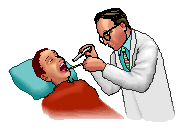| Module 6: Occupational Health Management - Section 3: Medical Screening and Surveillance |
| OHM3.4: Implementation and Audit Requirements |
 Once the medical surveillance programme has been established, the
medical examinations begin. These are usually conducted in a manner which is acceptable to the operational requirements of the workplace as well as to the logistic restrictions placed
on the medical team (such as nurse or doctor availability or whether the tests are conducted by outside providers).
Once the medical surveillance programme has been established, the
medical examinations begin. These are usually conducted in a manner which is acceptable to the operational requirements of the workplace as well as to the logistic restrictions placed
on the medical team (such as nurse or doctor availability or whether the tests are conducted by outside providers).
Each medical has the following components:
Compulsory Pre-Employment Examinations:
 These examinations should be conducted prior to employment, or at least within the first 14 days of employment as prescribed in the Hazardous Chemicals Substances Regulations. The responsibility to ensure that the examination is scheduled within the prescribed time deadline rests with the Human Resources personnel. Preferably, a written new recruit Induction Procedure should be in place, describing
these requirements.
These examinations should be conducted prior to employment, or at least within the first 14 days of employment as prescribed in the Hazardous Chemicals Substances Regulations. The responsibility to ensure that the examination is scheduled within the prescribed time deadline rests with the Human Resources personnel. Preferably, a written new recruit Induction Procedure should be in place, describing
these requirements.
These examinations are documented on the appropriate company form. Additional investigations over and above the standard examination are required only for certain job categories.
The occupation’s inherent medical requirements should be directed by the relevant Occupational Risk and Exposure Profile (OREP), and recorded in the Worker-Allocated Medical Surveillance Programme (WASP) applicable to that worker. This documentation (OREP and WASP) should be available to the examining doctor to ensure that appropriate attention is paid to any medical condition relevant to the work requirements, or potential exposure to hazards.
Should the applicant be found to be unfit for employment, it is the ethical responsibility of the Doctor to inform the applicant of the medical reason. In cases where the Doctor is unwilling to divulge the reason to the applicant, this should be communicated to the applicant’s own Doctor.
Compulsory or Statutory Periodic Examinations:
These are to be performed at least annually as prescribed by the schedule established by the Occupational Medicine Practitioner, and should be documented on an appropriate form.
The responsibility to ensure that the examination is scheduled within the prescribed time deadline each year is usually shared between the Medical Staff and the unit manager. The medical staff should submit a list of employees who are due for a medical examination during the following month, after which it is the responsibility of the unit manager to ensure that the employees are referred accordingly.
Compulsory (Statutory) Exit Examinations:
These are to be performed on employees that leave the services of the company, and who were exposed to recognised hazards, and the findings should be documented on an appropriate form.
These medicals should, within reason, be planned timeously, such as within a week of termination of services. The reason is that unexpected findings may require further actions (such as other tests, or referrals, or even a submission to the Compensation Commissioner, if a compensatable occupational disease is identified). The responsibility to ensure that the examination is scheduled within the prescribed time deadline rests with the Human Resources personnel.Note that this examination is not necessary if the last periodic medical was conducted within 6 months of the services being terminated.
Special Compulsory Examinations:
These are NOT routine examinations but should take place when the need arises, as determined through consultation between Management and the Company Doctor.
Their purpose is to ascertain the current health status of an employee or his/her suitability to return to, or to continue with work.
These examinations may take place under the following circumstances:
Offer Of Follow-Up (Post-Employment) Examinations:
 On the occasion of the medical examination at the termination of employment, the company may offer and recommend continued examinations to the employee,
usually with the same frequency. This will only be considered where the employee had been exposed to certain agents that continue to pose a threat to the person’s health, after exposure has ceased. This includes certain hazardous agents, such as asbestos and silica dust.
On the occasion of the medical examination at the termination of employment, the company may offer and recommend continued examinations to the employee,
usually with the same frequency. This will only be considered where the employee had been exposed to certain agents that continue to pose a threat to the person’s health, after exposure has ceased. This includes certain hazardous agents, such as asbestos and silica dust.
This offer and recommendation must be recorded in the written documents (reminder card) and handed over to the employee at the termination of his employment.
The Medical Surveillance Programme must be subjected to audit and evaluation from time to time.